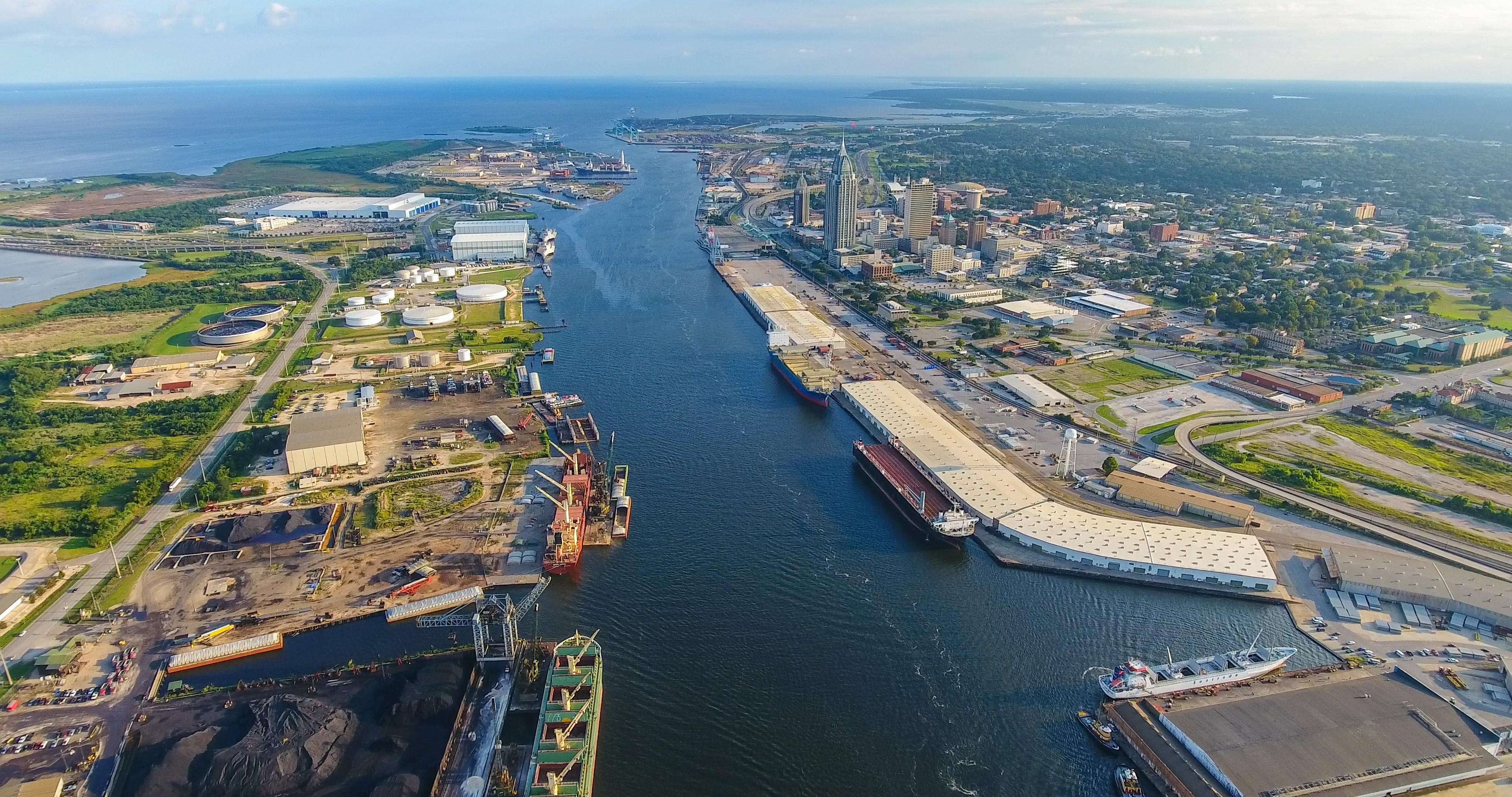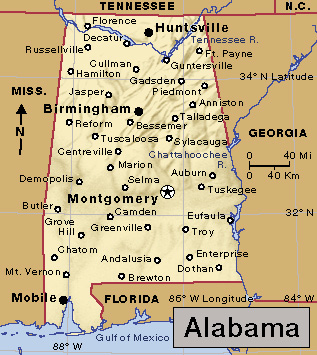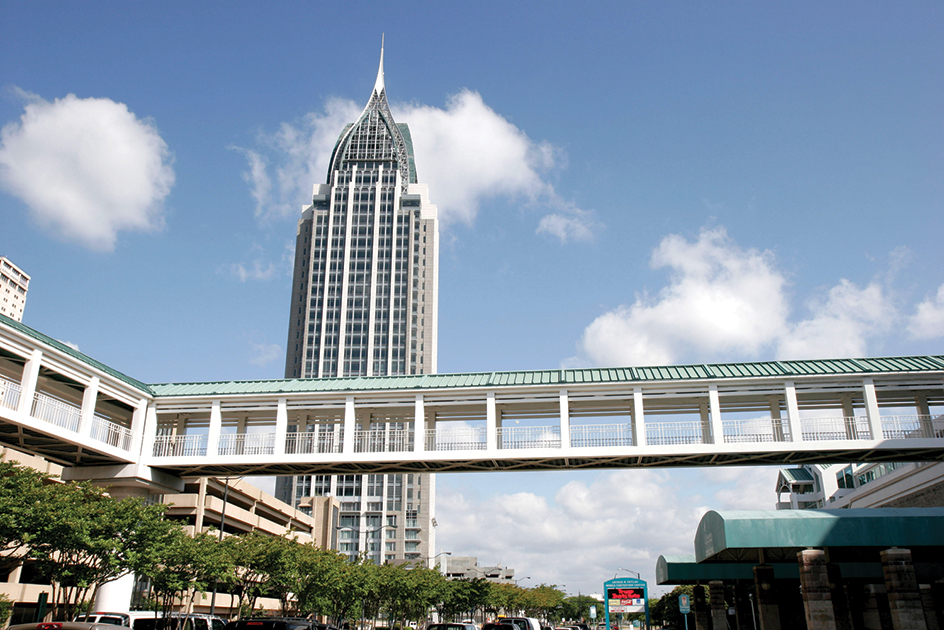Mobile, << moh BEEL >> (pop. 187,041; met. area pop. 414,809), is one of Alabama’s largest cities and its only seaport. Mobile lies on the Mobile River where the river flows into Mobile Bay, 31 miles (50 kilometers) north of the Gulf of Mexico.

Mobile is one of the nation’s oldest cities. A French-Canadian explorer founded it in 1702 as Fort Louis de la Mobile. He named the fort after the nearby Mobile, or Mabila, Indians, who belonged to the Choctaw tribe. Mobile is called the City of Six Flags because six governments have controlled it. France, Britain (now also called the United Kingdom), and Spain ruled Mobile in the 1700’s. Then the United States, the Republic of Alabama, the Confederate States of America, and again the United States flew their flags there.
The city
extends west of the Mobile River and covers 139 square miles (360 square kilometers) of land. It is the seat of Mobile County. The Mobile metropolitan area consists of Mobile County and covers 1,644 square miles (4,258 square kilometers).

The RSA Battle House Tower, a 35-story office building, is the tallest structure in downtown Mobile. The Mobile Civic Center, which includes an arena, a theater, and an exposition hall, occupies 12 acres (5 hectares) in the center of the city. The Brookley Aeroplex, an industrial park in southeast Mobile, is a former Air Force base.

Almost all of Mobile’s people were born in the United States. About half are African Americans. Mobile’s public schools belong to the Mobile County school system, the largest school system in Alabama. There are also many private and parochial schools in the city. Mobile is the home of Spring Hill College, the University of Mobile, and the University of South Alabama.
Mobile has a newspaper called the Press-Register that is published three times a week. The Mobile Public Library has several branches.
Mobile has a symphony orchestra and a small opera company. The Mobile Civic Center presents such events as the Distinguished Young Women program (formerly America’s Junior Miss), ballet productions, basketball games, and circuses. The Arthur R. Outlaw Mobile Convention Center hosts a variety of activities, including industrial shows and corporate conventions. The city celebrates Mardi Gras each year (see Mardi Gras). The Historic Mobile Preservation Society and other groups maintain several homes as they were in the 1800’s. Historic aircraft are displayed in USS Alabama Battleship Memorial Park, located along Mobile Bay. The park also includes the battleship USS Alabama, which fought in World War II, and the USS Drum, a World War II submarine.
Mobile’s Ladd-Peebles Stadium is the home of the annual Senior Bowl football game between teams of top college players. Bellingrath Gardens, south of the city, displays flowers, shrubs, and trees from throughout the South. Several streets in Mobile and its suburbs form the 35-mile (56-kilometer) Azalea Trail, where thousands of azalea plants bloom every spring.
Economy.
The economy of the Mobile area is diverse. Manufacturing, construction, wholesale and retail trade, shipping, health care, and government operations are all important to the economy. The city has hundreds of factories. They build, refurbish, and repair aircraft and ships and produce such products as aircraft engines, carpets, chemicals, paper products, steel, and wood products. Schools, hospitals, and government agencies employ many people.
The Port of Mobile is one of the busiest ports in the Southern United States. It handles large amounts of chemicals, coal, lumber and wood products, and metal products. Shipyards at the port repair and maintain ships that service the port. In 1985, the Tennessee-Tombigbee Waterway opened Mobile’s harbor to about 16,000 miles (26,000 kilometers) of navigable inland waterways (see Tombigbee River). The waterway connects the Tennessee River with the Tombigbee River. Five railroads and numerous trucking companies provide freight service to Mobile. Amtrak trains stop there. Several bus lines and steamship firms serve the city. Airlines use Mobile Regional Airport just outside Mobile. Three tunnels carry traffic under the Mobile River.
Government.
Mobile has a mayor-council form of government. The voters elect a mayor and seven council members to four-year terms. Mobile gets most of its revenue from taxes on licenses, property, and sales.
History.
Jean Baptiste Le Moyne, Sieur de Bienville, a French-Canadian explorer, founded Fort Louis de la Mobile in 1702. Sieur de Bienville established the fort as a trading post and a French outpost to control nearby Indians. In 1711, river floods forced the colony to move 27 miles (43 kilometers) south to the present site of Mobile.
France gave Mobile to Britain in 1763 after the French and Indian War (1754-1763). Spain captured Mobile in 1780, and the United States seized it in 1813. Mobile was incorporated as a city in 1819.
Mobile became an important seaport during the early 1800’s as cotton production flourished in the South. The Battle of Mobile Bay, won by Union forces under Rear Admiral David G. Farragut in the American Civil War, closed Mobile’s port in August 1864. The city fell nine months later, the last Southern stronghold to surrender.

The Civil War crippled cotton production in the South, and Mobile suffered economically. However, exports of lumber and naval supplies and imports of general cargo gradually strengthened the city’s economy. By the beginning of World War I (1914-1918), Mobile was again a thriving seaport. Between World War I and World War II (1939-1945), Mobile became a shipbuilding and railroad center. In 1940, workers finished building the Bankhead Tunnel. The tunnel carries automobile traffic under the Mobile River. Construction of an Army Air Forces supply base in Mobile during World War II and an expanding paper industry after the war boosted the city to its greatest period of growth. Mobile’s population increased from 78,720 in 1940 to 202,779 in 1960.
Mobile’s economy suffered again during the 1960’s, when the federal government gradually closed Brookley Air Force Base in the city. In 1964, Mobile began Task Force 200, a plan to encourage industrial development in the city. As part of the project, Mobile purchased the abandoned military base in 1969 and created what is now the Brookley Aeroplex. The city leases buildings and land in the complex to industry. From 1964 to 1969, Task Force 200 expanded Mobile’s industrial employment by more than 16,000 jobs.
As in other cities both North and South, public school integration was a major problem in Mobile during the 1960’s. Federal court orders forced Mobile to integrate some schools beginning in 1963. As the result of a 1968 ruling by a U.S. Court of Appeals, the city established widespread school integration in 1970. Many white people then set up private schools for their children.
Mobile rebuilt much of its downtown area during the 1960’s. Housing projects and office buildings replaced hundreds of old structures. Two more automobile tunnels under the Mobile River opened in 1975. During the 1980’s and 1990’s, many new businesses began in Mobile and existing ones expanded. The Mobile Convention Center (now Arthur R. Outlaw Mobile Convention Center) opened in 1993.
